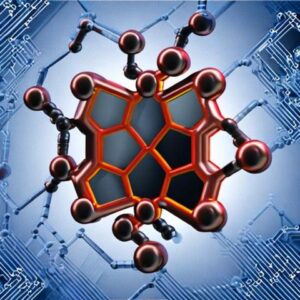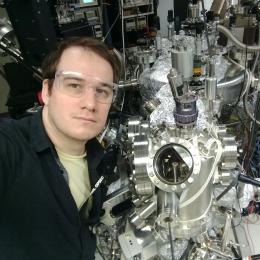
Deep Learning–based Data Analysis Software by ORNL Promises to Accelerate Materials Research
April 17, 2023 — Researchers at the Department of Energy’s Oak Ridge National Laboratory have developed a machine-learning inspired software package that provides end-to-end image analysis of electron and scanning probe microscopy images.

An AI-generated image representing atoms and artificial neural networks. Credit: Maxim Ziatdinov, ORNL.
Known as AtomAI, the package applies deep learning to microscopy data at atomic resolutions, thereby providing quantifiable physical information such as the precise position and type of each atom in a sample.
Using these methods, researchers can quickly derive statistically meaningful information from immensely complex datasets. These datasets routinely include hundreds of images that each contain thousands of atoms and abnormalities in molecular structure. This improvement to data analysis allows researchers to engineer quantum atomically precise abnormalities in materials, and can be used to gain deeper insights into the materials’ physical and chemical qualities.
Electron microscopy and scanning probe microscopy allow materials scientists, physicists and other researchers to probe atomic and molecular structures at extremely high resolutions. These high-resolution methods allow researchers to clearly observe atomic structures, making them an important tool in understanding and engineering materials at the nanoscale. Electron microscopy is useful for gaining precise information on the structure of a material, whereas scanning probe microscopy is more often used to learn about a material’s functional properties, such as superconductivity or magnetism. Both methods benefit from modern image analysis methods.
Deep learning is a kind of machine learning that allows a program to train itself to accurately identify the contents of an image or block of text. When traditional machine learning is applied to image analysis, relevant features are manually extracted from a set of images — a process known as feature engineering — and used to create a model that categorizes objects based on those features.
In contrast, deep learning models automatically learn relevant features by using a network of layered “neurons” — biologically-inspired nodes through which data and computations flow — trained to detect various aspects of an image at different levels of complexity. This allows for increased precision and the analysis of more diverse information when compared with traditional machine learning, so long as enough data exists to train the system.
AtomAI, which was developed partially at ORNL’s Center for Nanophase Materials Science, includes a unique model architecture to identify thin objects such as nanofibers or domain walls — the interfaces separating magnetic domains — in microscopy data. The software package is also built to reduce errors in image processing by accounting for unintended changes in the image data, such as incoming cosmic rays or images of non-target materials, and by incorporating certain unchanging physical characteristics into the model.
Also, AtomAI includes tools that allow researchers to conduct real-time analysis of the data being gathered and to import information directly into theoretical simulations. These features are useful for gaining insights into the energetics and optical, electronic and magnetic properties of the physical structures being observed.
An overview of the software package was published in Nature Machine Intelligence.
“People used to treat microscopy as a purely qualitative tool,” said Maxim Ziatdinov, a researcher at ORNL and the lead developer of AtomAI, “but recently there was sort of a shift in the mindset of the community: Microscopy can actually be used to extract quantitative physical information.” Qualitative microscopy methods generally rely on researchers noting holistic information about a sample, while the new quantitative methods allow for precise numerical representations of a material’s structure or properties.
Software such as AtomAI has enabled this shift, providing a method to quantitatively analyze the structures of whole samples to find meaningful data that qualitative methods might misrepresent or simply not notice.
Ziatdinov expects his team’s work to accelerate the rate of progress in both fundamental and applied materials research. “If you can characterize things faster and automate at least some parts of the process, then you will also speed up all aspects of materials science research,” he said.
AtomAI was designed with ease of use and access in mind. The entire package can be launched from a browser and requires minimal coding knowledge to operate.
“If you’re an experimentalist, then you should be able to use machine learning without knowing all the math behind the process and without necessarily being a good coder,” Ziatdinov said.
AtomAI is a complete software package, and Ziatdinov and his team expect to expand its capabilities and support more features. He is particularly interested in adding functionality for theoretical researchers looking for accurate estimates of structures’ physical characteristics, such as energetics and stability, without going through the time-consuming and expensive process of traditional simulations.
Ziatdinov is also looking forward to hearing directly from other researchers about their needs and ideas for AtomAI and is working with them to integrate new features into the software package.
ORNL is managed by UT-Battelle for DOE’s Office of Science, the single largest supporter of basic research in the physical sciences in the United States. DOE’s Office of Science is working to address some of the most pressing challenges of our time. For more information, visit energy.gov/science.
Source: Galen Fader, ORNL































